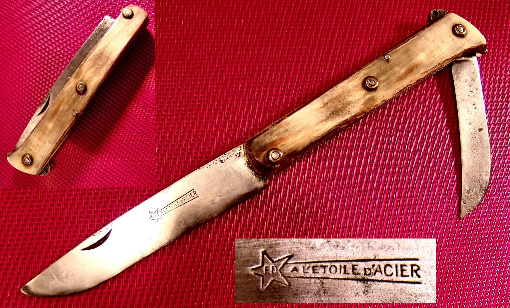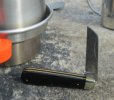LOL, thanks my friend!
That region of Spain sounds great. My friends in the north of Ireland spoke very highly of the hospitality of the Basque folk along the Western Pyrenees of Spain and France, as well.
Yes, I would guess the export ban might have something to do with Sambar deer having been declared 'Vulnerable' in their home ranges in India and Sri Lanka in 2008.
The Australian herds, mostly in Victoria were the results of releases by British 'Acclimatization Societies' from the 1860s onwards. All the early releases were in bushland within an hours drive, or less of where I live. The Game Management Authority estimates the current Sambar deer population just in this State, at 750,000-1,000,000.
The problem regarding utilising some of these Sambar deer antlers as a renewable resource for knife handles is twofold.
Firstly, Sambar are rarely commercially farmed - they are notoriously flighty in captivity. I know of a couple of deer farms that have some, as a kind of game ranch business, but observing the deer even in that situation as a visitor (being fed at the same time each day etc.), they never seem to lose their legendary wariness, and masterful stealth and evasiveness. One of the farms, I recall, did sell their Sambar antler cast offs. I read a story from an Indian paper just the other day, about wildlife officers being investigated for foolishly trying to rope a wild Sambar stag running loose in a school precinct - the stag was a mighty animal, but it still died from the shock of being 'wrangled' by them.
Venison farms and 'behind the wire' operations usually prefer to raise Fallow deer and Red deer.
Then, with regard to hunted wild Sambar antler - many deer hunters may have a special piece reserved for their own custom knife, but apart from that, generally like to keep their antlers intact.
Among hunters, it's no small thing to be given Sambar antlers by another hunter. Other deer species' antlers are not necessarily seen in this way.
Great post JP.
'Crying' is a perceptive way of putting it.
Reminded me in Japan, I was curious to see what an elderly master bladesmith would say about an intricate, tightly patterned, damascus bladed/timascus handled modern folder I showed him a photo of.
'
Aieeee', he sucked air in through his teeth, and muttered 'that hurts my eyes' in Japanese!
LOL. Yes, I agree R8shell that hunted Sambar is not really a sustainable way of sourcing antler. I assume in India, where cast antlers were 'harvested', they must have had forested farms, enclosed by high deer-proof fences, so they would be assured of being able to find the cast off antlers from the confined deer each year.
I don't mind a bit of forward blade cant either, although there's a level I guess, where it starts to look barbarous, or sloppy. I generally prefer to judge knives based on hand feedback, rather than by eye, whether a pattern works well, or not, anyway.
'Fallow' in this case, SP, comes from this deer species' preferred habitat of transitional, or 'fallow' ground where improved pasture fringes meet light timber and forest.
Thanks, my friend.
Yes, all good advice.
I don't know if I've
ever returned a knife. Hardly worth it from Australia, so I just make 'em work, or give 'em away. Remember, at a local UK retailer, these knives go for around $35-45USD, so that has a strong bearing on the amount of finishing work done. In fact, this really makes them cousins of the sodbuster/
mineur knife in a way, in terms of price point. When I was looking over probably two dozen or more A. Wright knives in the Famous Sheffield Shop to choose mine, they all had 'flaws' of some kind. But clearly, many of them are able to serve their intended purposes well, and I usually work over my knives a bit, before use anyway, so it doesn't bother me that much on some. Others I've had a series of frustrations with, but have worked through them in the end, and also learned more about knives because of it.
Nice work, Jack - the cant on that JR looks well within the 'margin of acceptability' - to me, anyway. Thanks for taking the time to put that post together too.
Those knives you're concerned about just look like they started as a standard Wright stamped Lambsfoot blank, and have simply been ground down in the 'nose' area a bit more. It's hard to see in the photos, but given the minimal evidence of a swedge, the regrinding may have happened to the blade after it left the Wright factory. Or it could just be that there's a bit of latitude in style depending on which cutler, or apprentice made it. They look fine to me, honestly. I've done the same with my Ox horn Lambsfoot. The modern Taylors Eye Witness sports a similar blade profile.
Interesting to read your sequence of posts Dylan. I've been through a similar progression of emotions regarding some of my Wright Lambsfoot knives. I've certainly spent more time on getting them the way I like them - with sandpaper, stone and strop - than on most of my other pocketknives, but somehow, I also like them more as users than many other of my knives as well.
That old world charm you mentioned, is a factor for me, as well as those ergonomic and practical aspects.
Great action shots Jack! Do you ever use birch bark as tinder, or for scraped punk? I recall seeing small stands of it in Ireland and England. One of my regular walks intentionally winds through a mixed stand of Canoe birch, next to a few acres of Japanese Monarch birch. I always keep some dried birch rolls in my 'possibles bag'. Burns fantastic.
Greg: that sounds like a great trip, you must have seen some amazing coastline.
Hmm, action shots you say?
I suppose this is some
lite action:
trimming down chilli stalks...

















